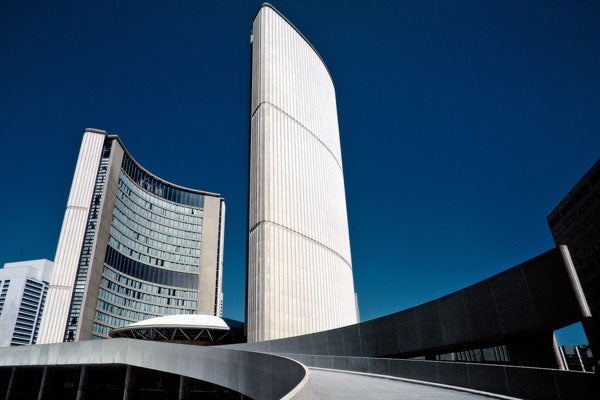
Five frequently asked questions about Toronto’s finances
Published: August 14, 2014
What should Toronto’s mayoral and council candidates – and the city's voters – understand about the city’s finances?
How about the fact that Toronto has no spending problem and its debt is “relatively modest” but the city can’t maintain its infrastructure (let alone build new) without more revenue?
Those are just a few of the questions answered by Enid Slack and André Côté of the University of Toronto’s Institute on Municipal Finance & Governance in their latest research findings.
Released this week, Is Toronto Fiscally Healthy? A Check-up on the City’s Finances offers mayoral candidates and voters a primer on where Toronto stands compared to other cities in terms of growth, spending, taxes and other revenues.
Slack and Côté shared a few of the highlights of their study with U of T News. (You can also read the complete paper.)
Overall, what is the diagnosis on Toronto's fiscal health?
The City of Toronto’s fiscal health is sound by most measures, but it faces cost pressures and its aging infrastructure and investment needs present a huge financial challenge.
Ultimately, you get what you pay for. With low residential property taxes, high public expectations for city services, and considerable infrastructure maintenance and investment needs, Toronto’s candidates and voters will have to choose between paying more or getting less of the services or new transit lines they want.
New revenues are most needed to address the infrastructure funding shortfall. Queen’s Park and Ottawa have a role to play, but the city cannot simply wait for its pleas for funding to be answered (after all, there is little reason to expect they will be). In this context, Toronto needs access to new taxes to grow as a world-class city.

Toronto’s funding shortfall for maintaining existing assets, such as transportation infrastructure, in a state of good repair will grow to nearly $2.5 billion by 2020. Toronto Community Housing alone reports an $860 million unfunded repair bill for social housing.
There is also significant demand for new infrastructure to accommodate Toronto’s growth, and to tackle worsening congestion. But there is no funding available for big new proposals, such as the much-talked-about transit investments.
There is also uncertainty about funding sources in the long-term capital plan. Provincial and federal transfers represent a third of planned infrastructure spending – leaving the City vulnerable to the changing whims of other governments that are struggling to balance their budgets. The City will also rely more on “capital from current” – meaning, property taxes and other operating revenues – and less on borrowing and debt, which could put pressure on service spending.
Toronto’s net debt – meaning the value of liabilities minus assets – totals about $4 billion. This seems like a big number, but what is more important is the question of whether the City can pay off that debt.
A more useful measure is a government’s debt relative to its operating revenues, which gives a better sense of capacity to meet debt servicing costs. By this measure, Toronto fares quite well relative to other big Canadian cities, regions and provinces – recognizing of course that there are differences in responsibilities, and also that provinces have access to a broader array of revenue sources.
With a strong economy, solid credit ratings, low interest rates, and a manageable debt load, Toronto is in good shape. In fact, Council’s self-imposed debt ceiling – which caps the amount the City can borrow to pay for infrastructure – could actually limit the City’s flexibility to invest for the future.

What about property taxes?
 Property taxes in Toronto have been growing at less than the rate of inflation – meaning the property tax burden per household has actually been falling. Toronto residents, on average, pay low property taxes compared with residents of other Ontario cities. This is in part because the tax burden continues to be much higher on businesses.
Property taxes in Toronto have been growing at less than the rate of inflation – meaning the property tax burden per household has actually been falling. Toronto residents, on average, pay low property taxes compared with residents of other Ontario cities. This is in part because the tax burden continues to be much higher on businesses.
To keep residential property taxes low, the City has also relied on increased revenues from user fees and charges, the land transfer tax, and – most significantly – transfers from the provincial and federal governments. The provincial “uploading” of some social service costs has also helped.
The Institute on Municipal Finance and Governance (IMFG) is an academic research hub and non-partisan think tank based in the Munk School of Global Affairs at the University of Toronto. It is the only institute in Canada that focuses solely on municipal finance issues in large cities and city-regions.



